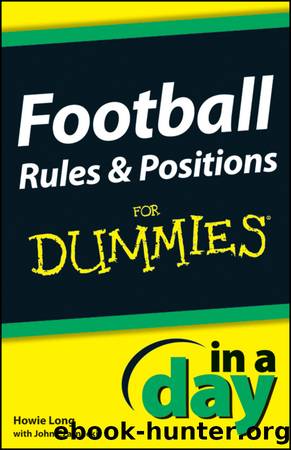Football Rules & Positions In a Day For Dummies by Howie Long

Author:Howie Long
Language: eng
Format: epub
Publisher: Wiley
Published: 2012-09-15T00:00:00+00:00
Illustration by Wiley, Composition Services Graphics
Figure 3-3: The right way to catch a football.
A player is out of bounds whenever he steps from the field of play and touches (or flies over) the white sidelines or end lines. To remain inbounds for a catch, an NFL player must have both feet (including the toes of his shoes) touching the ground inside the end lines and sidelines and must be in possession of the football. In college and high school football, a player needs to have only one foot inside the end lines and sidelines to be considered inbounds while in possession of the football.
On their way to catching the ball, receivers must run exact pass patterns with the quarterback throwing the football to predetermined spots on the field. To read about basic pass patterns, go to www.dummies.com/inaday/footballrulesandpositions.
Hitting the Ground Running
In football, the ground game refers to running the football (as opposed to passing it). Running the ball is the basic premise of football, and itâs the easiest way to move the ball. A team runs three times and gains 10 yards, and thatâs good enough for a first down and another set of four downs. What could be easier?
Running the ball is the best way to maintain possession and keep the clock moving when a team is ahead because the clock doesnât stop if a player is tackled inbounds. This ploy is called ball control. However, if the quarterback throws an incompletion, the clock stops. Stopping the clock is good for the defense; it gives them a breather and the hope that they may get the ball back. So when a team is running the football successfully, usually itâs physically whipping the other team. And thatâs the object of the game!
Meeting the men who play the ground game
Understanding whatâs going on during running plays is much easier when you know whoâs responsible for the running game.
The next time you see an offense set up, look for the two players who line up in the offensive backfield (the area of the field behind the quarterback and the line of scrimmage). These players are the running backs. The smaller one is the main ballcarrier, and the larger one is the guy charged with protecting the ballcarrier.
On most teams, the principal ballcarrier is called the halfback (also called the tailback or the running back). When teams find a good running back, they give him the ball. And they give it to him as often as heâs willing and able to carry it.
When a team employs two running backs in the offensive backfield, the bigger of the two is usually called the fullback. Heâs there to block and clear the way for the halfback. You may think that the fullbackâs job is a thankless one, but most fullbacks get a lot of satisfaction from making a great block (generally on a linebacker) and winning the physical battle against players who tend to be bigger than they are.
The job description
A running back has a responsibility, or assignment, on every play.
Download
This site does not store any files on its server. We only index and link to content provided by other sites. Please contact the content providers to delete copyright contents if any and email us, we'll remove relevant links or contents immediately.
Relentless: A Memoir by Julian Edelman(1755)
The Source by James A. Michener(1491)
Cristiano Ronaldo: The Biography by Guillem Balague(1478)
ALEX FERGUSON My Autobiography by Alex Ferguson(1450)
1942 by Winston Groom(1416)
Football's Strangest Matches by Andrew Ward(1403)
When Pride Still Mattered by Maraniss David(1316)
Time's Champion by Time's Champion (Craig Hinton & Chris McKeon)(1221)
Chiefs by Stuart Woods(1219)
Where Men Win Glory: The Odyssey of Pat Tillman by Jon Krakauer(1143)
Gunslinger by Jeff Pearlman(1131)
0.721 by Gary Webster(1114)
Paterno by Joe Posnanski(1082)
Snake by Mike Freeman(1052)
Coming Back Stronger by Drew Brees & Drew Brees(1046)
Texas Monthly On… by Texas Monthly(1044)
League of Denial by Mark Fainaru-Wada(1018)
Deal Breaker by Harlan Coben(1009)
It Takes What It Takes by Trevor Moawad(999)
